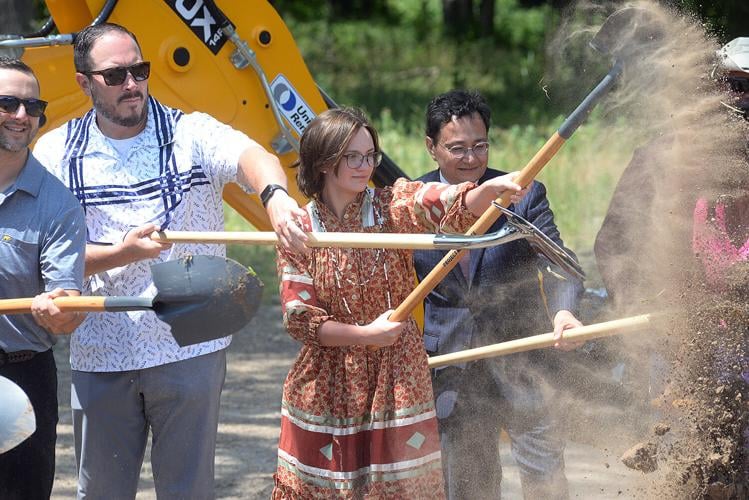
- Details
- By Chuck Hoskin Jr
Guest Opinion.Cherokee culture is one of our most valuable treasures, but we don’t protect it by building barriers or hiding it away. Cherokee culture is best protected when it’s celebrated and shared.
In 2020, my daughter Jasmine suggested a playground across the street from the W.W. Keeler Tribal Complex. She was 14 years old at the time, I was newly elected Chief, and I thought it was just a plain good idea. Like many of our young Cherokees, she recognized an overlooked area and saw the possibilities to create something that will inspire future generations.
Jasmine’s idea grew, as good ideas do, and other strong-willed Cherokee women became involved, including Felicia Olaya, daughter of the late Cherokee Nation Principal Chief Wilma Mankiller. Felicia and other members of the Mankiller family reviewed concept ideas for the park and helped to shape what it eventually will turn into.
Deputy Chief Bryan Warner and I took Jasmine’s idea and turned it into a proposal for the Council of the Cherokee Nation. I want to thank the Council for their approval of the Principal Chief Wilma P. Mankiller Capitol Park Act in 2022 that made this park possible.
Recently, it was my honor to stand alongside Jasmine, now 18 years old, and representatives of the Mankiller family to break ground on the Wilma P. Mankiller Capitol Park, which is tentatively scheduled to be completed in the fall of 2025. The $10 million project will be open to all – Cherokee and non-Cherokee, Native and non-Native – as a celebration of our culture.
The park will span nearly 15 acres and will transform the vacant property into a vibrant community space. There will be a playground area, an area for traditional Cherokee games, a basketball court, a community building, a small amphitheater, green space, paved and hiking trails, an area for food trucks, public art, an heirloom garden, a picnic pavilion, a dog park and more. I’m particularly excited to see a coming statue that will honor the late Chief Mankiller.

Her legacy is inclusiveness, Cherokee progress and freedom of expression – all of which will become themes that visitors will see reflected in the park’s offerings.
On the theme of inclusiveness, this park creates a new access point along an incredibly important corridor in our region. For me, the crown jewel of sharing our culture will always be Cherokee National Holiday, held once a year in the heart of Cherokee Nation. Every year, I meet Cherokees who are visiting the Cherokee Nation Reservation for the first time to join the celebrations at Cherokee National Holiday. For some of them, they are reconnecting to their heritage and taking a first step to bridge a generational divide.
As they drive down U.S. 62 toward Tahlequah and see Sequoyah High School, the tribal complex and the bustling One Fire Field, it all clicks. The vague concept they had instantly transforms into a living monument. They see our nation working and growing with their own eyes and are changed because of it.
Soon, the Wilma P. Mankiller Capitol Park will welcome Cherokees home during National Holiday and throughout the year. I can think of no greater guardian than Chief Mankiller to welcome all who want to share our culture.
Chuck Hoskin, Jr. is the principal chief of the Cherokee Nation.
More Stories Like This
Why Federal Health Insurance Policy Matters to Cherokee NationThe Absence of October's Job Report Shows Why Native American Communities Need Better Data
Tribal IDs Are Federally Recognized. ICE Agents Are Ignoring Them.
Thanksgiving: Part of "Broken Circle Holiday"
Thanksgiving is a Tradition. It's Also a Lie
Help us defend tribal sovereignty.
At Native News Online, our mission is rooted in telling the stories that strengthen sovereignty and uplift Indigenous voices — not just at year’s end, but every single day.
Because of your generosity last year, we were able to keep our reporters on the ground in tribal communities, at national gatherings and in the halls of Congress — covering the issues that matter most to Indian Country: sovereignty, culture, education, health and economic opportunity.
That support sustained us through a tough year in 2025. Now, as we look to the year ahead, we need your help right now to ensure warrior journalism remains strong — reporting that defends tribal sovereignty, amplifies Native truth, and holds power accountable.
 The stakes couldn't be higher. Your support keeps Native voices heard, Native stories told and Native sovereignty defended.
The stakes couldn't be higher. Your support keeps Native voices heard, Native stories told and Native sovereignty defended.
Stand with Warrior Journalism today.
Levi Rickert (Potawatomi), Editor & Publisher

